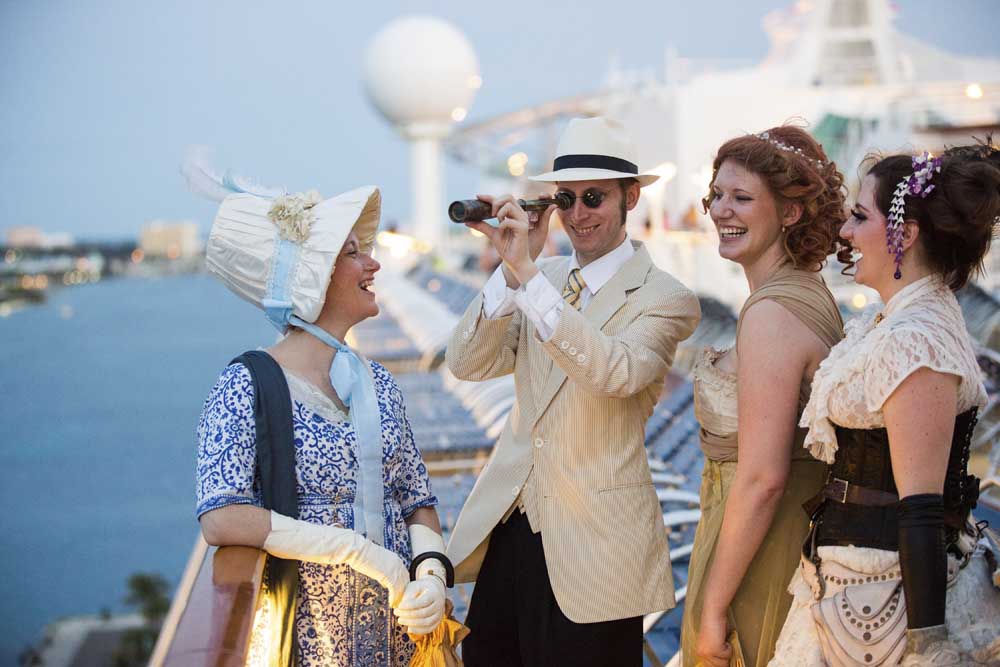Cruising the Caribbean in Victorian style
Published 12:00 am Sunday, March 16, 2014

- Photos by Piotr Redlinski / New York Times News ServiceSteampunks gather on the top deck of a Royal Caribbean cruise ship in Nassau, Bahamas. Steampunk is a neo-vintage genre that seeks to capture the 19th century’s spirit of adventure and the whimsy of its steam-fueled innovations.
On the first full evening of last month’s second annual Steampunk cruise to the Bahamas, I found myself — in tuxedo and a World War I-era aviator’s cap — marching in a strange parade past the Deck 5 duty-free shops on the Royal Caribbean cruise ship Explorer of the Seas. Strolling with me were 62 elaborately costumed Victorian re-enactors, including but not restricted to: a Gypsy minstrel playing the accordion, a princess in authentic Turkoman beads, a Russian submarine commander, an African explorer in safari gear, some mustached gentlemen in John Bull top hats and, in her tiara, a 60-year-old woman dressed up as Her Majesty the Queen.
I was at the back the procession and had a glimpse of the vessel’s other passengers, who, lined on either side of the parade, were busy taking pictures with their iPhones, no doubt thinking that we were staging yet another of the cruise ship’s many shows. Steampunk, if the term is unfamiliar, is a neo-vintage genre that, taking inspiration from science-fiction classics like “The Time Machine,” seeks to capture the 19th century’s pith-helmeted spirit of adventure and the whimsy of its steam-fueled innovations. Which is to say, not exactly what our fellow cruisers in their fanny packs had thought they’d find at the end of a day of frozen margaritas and stuff-your-face buffets.
Trending
But then, of course, that was the point. The Steampunk parade, organized like the outing itself by a company called Whodunit Productions, was not a show — at least not in the sense of a spectacle meant for others. Its 60 participants, who boarded the Explorer — which can take about 3,100 passengers — to spend a week with other lovers of spats and kilts and monocles and goggles, were simply exhibiting their plumage in a celebratory coming out at sea.
“When people tell me I’m eccentric, I correct them,” a man named Douglas Gowin said at the get-to-know-you mixer that took place after we were underway from Port Bayonne, N.J. “I’m not eccentric, I’m very eccentric. That’s the whole reason for coming on a thing like this. To meet other people as quirky as me.”
Gowin, 55 and extravagantly bearded, found his way to Steampunk a year or two ago after an eclectic career as a licensed optician, a costume designer and the U.S. ambassador to the World Santa Claus Congress, which is held each summer in the Danish town of Bakken outside Copenhagen, Denmark. A handyman by nature, he was drawn to the community by its DIY aesthetic. “I like making things,” he told me with a shrug, showing off the antique spectacles he’d fashioned out of gears.
Like several other Steampunks I encountered, Gowin initially introduced himself in the guise of a Victorian alter ego, which in his case, according to the business card he freely passed around, was a “Tinker, Taylor and Time Traveler” named Dr. Nosmo King. By the end of the evening, a dozen such cards were poking from my pockets. I’d gotten one from Professor R.W. Supernius, “A Maker of Wondrous Artifacts,” who in real life was Todd W. Spencer, a Hollywood special effects man. Then there was another from “The Travelin’ Smiths,” or Dan and Linda Smith, a Canadian couple in their 50s.
A lesson from the professor
Hoping to learn a bit more of the basics, I invited G.D. Falksen to join me for a cocktail when the mixer broke up. Falksen, in his rimless glasses and three-piece suit, was the journey’s resident intellectual, hired to be on hand to answer questions about the history and culture of Steampunk, and to generally lend the trip some academic ballast.
Trending
As we sat down over gimlets and martinis, he rearranged his waistcoat and offered me a preview of the speech he planned to deliver in the morning, a survey of sorts that he had titled Steampunk 101. “Steampunk is essentially Victorian science fiction,” he explained, adding that it first emerged in the 1980s as a literary trend whose best-known authors — William Gibson, say, or K.W. Jeter — wrote about the tensions of industrialization and technology’s effect on the society of empire. By the end of the millennium, these Steampunk fictions had been more or less supplanted by what Falksen called “the visual veneer” of its fashion-conscious lifestyle. Steampunk magazines appeared online, with pocket-watch reviews and helpful tips on how to sew a bustle. Steampunk conventions began popping up at semipublic venues like the Radisson in Piscataway, N.J.
The appeal of all of this, Falksen said, was that Steampunk culture provides a way to rebel against the tenacious informality of the contemporary moment. “People like the elegance and the manners,” he went on. “It caters to their taste for sophistication and gives them a stronger sense of self.”
Dickens in the Caribbean
It was a stretch from the start that Evelyn Kriete, the party planner who organized the trip, had thought to place a group of anti-moderns on a hypermodern cruise ship whose every detail appeared to embody the crass consumer culture they were trying to escape. Then there was the whole Dickens in the Caribbean thing, which was not an easy fit. “I just tell them to wear light colors when they go ashore,” Kriete said, “and to watch themselves for heat stroke.”
On the third day, the ship pulled in to Port Canaveral, Fla., and Kriete’s agenda required the Steampunks to debark for a field trip to the Kennedy Space Center. Their tour guide seemed unfazed as they, in their anachronistic outfits, motored on a bus past rows of NASA rockets. By the end of the excursion, he had asked more questions of the Steampunks than the Steampunks had of him.
When they returned that night, there was a special event in the Deck 12 pool: a performer in a bright blue fishtail was called upon to entertain the Steampunks with a mermaid dance. As she turned and twisted in the chlorinated water, flopping under burning Florida stars, some regular passengers wandered down from an adjoining disco party to observe.
The two groups of lookers-on could not have been more different. Gowin, for one, had appeared at the dance with an antique lantern and his bulging body covered in a two-piece, red-striped swimsuit. The “normal” cruisers had their own props: heaped dessert plates, Bud Light bottles, sippy cups of rum.
And yet both factions were so visibly entranced by the performance that I couldn’t help but wonder: If Steampunk was a fantasy in which enthusiasts of evening wear adorned themselves in the fashions of the past, then wasn’t cruising, too, a sort of fantasy? Wasn’t it its own form of costume play in which ordinary people set aside their lives and enjoyed, by way of lobsters in the tropics, the brief illusion of being upper class?
Once the dance was over, both sides took their clothes off and jumped together into the Jacuzzi. And, of course, at that point, it was hard — if not impossible — to tell who were the masqueraders playing make-believe.








